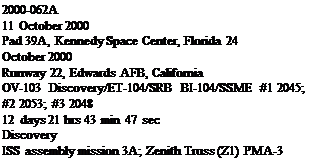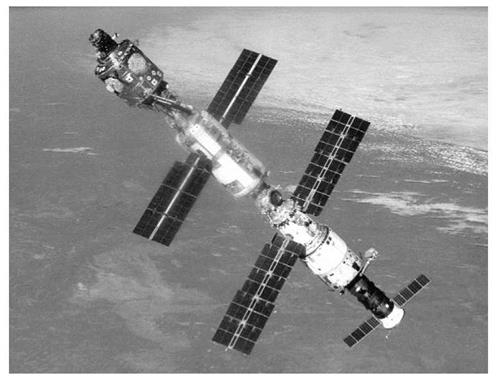STS-106
|
Int. Designation |
2000-053A |
|
Launched |
8 September 2000 |
|
Launch Site |
Pad 39B, Kennedy Space Center, Florida |
|
Landed |
20 September 2000 |
|
Landing Site |
Runway 15, Shuttle Landing Facility, KSC, Florida, |
|
Launch Vehicle |
OV-104 Atlantis/ET-103/SRB BI-102/SSME #1 2052; #2 2044; #3 2047 |
|
Duration |
11 days 19 hrs 12 min 15 sec |
|
Call sign |
Atlantis |
|
Objective |
ISS assembly flight 2A.2b |
Flight Crew
WILCUTT, Terence Wade, 50, USMC, commander, 4th mission Previous missions: STS-68 (1994); STS-79 (1996); STS-89 (1998)
ALTMAN, Scott Douglas, 41, USN, pilot, 2nd mission Previous mission: STS-90 (1998)
LU, Edward Tsang, 37, civilian, mission specialist 1, 2nd mission Previous mission: STS-84 (1997)
MASTRACCHIO, Richard Alan, 40, civilian, mission specialist 2 BURBANK, Daniel Christopher, 39, USCG, mission specialist 3 MALENCHENKO, Yuri Ivanovich, 38, Russian Air Force, mission specialist 4, 2nd mission
Previous mission: Soyuz TM19 (1994)
MORUKOV, Boris Vladimirovich, 49, civilian, Russian, mission specialist 5
Flight Log
The Russian Service Module Zvezda docked to the aft port of Zarya on 26 July 2000, and was followed by Progress M1-3 at the aft port of Zvezda on 8 August. Zvezda was critical to the early occupation of ISS because it provided flight control and orbit maintenance functions. Zvezda also included the crew quarters for the early resident crews, and EVA facilities prior to the arrival of the airlock modules. With the arrival of Zvezda, a resident crew could remain on the station without the Shuttle being docked to it.
STS-106 docked to Unity on 10 September and remained there for 189 hours, during which the hatches were opened for over 129 hours. On the mission’s only EVA on 10 September (6 hours 14 minutes), Lu (EV1) and Malenchenko (EV2) connected nine power and data communication cables between Zvezda and Zarya as well as installing the station’s compass, a 1.82-metre magnetometer which showed the station in respect to the Earth. They also ventured farther than any tethered crew member had
|
The ISS configuration as of September 2000, photographed by the departing STS-106 during a fly-around manoeuvre. From left, US Unity Node, Zarya Control Module, Zvezda Service Module, Progress M1-3 |
during a Shuttle EVA, over 30.4 metres above the cargo bay along the side of Zvezda and Zarya.
Work inside the station focused on reconfiguring Zvezda for operational use by removing launch bolts and restraints and installing voltage and current stabilisers inside the module. To save weight at launch, only five of the eight batteries had been installed, and the STS-106 crew installed the other three. They also installed components of the Elektron system designed to separate water into oxygen and hydrogen. The three tons of logistics transfers and numerous maintenance tasks took up most of the crew’s time during the docked phase. Managers monitoring onboard consumables were able to approve an extra day of docked operations to help ease the burden. The items transferred included six water containers, all of the food stores for the first resident crew, office supplies, onboard environmental supplies, a vacuum cleaner and a computer with monitor.
Atlantis undocked, after a further re-boost to the station’s orbit, on FD 11. This was followed by a fly-around of the station before commencing the preparations for the flight home. This undocking and fly-around manoeuvre, like those during the undocking of the Shuttle from Mir, is normally performed by the Shuttle pilot, giving
them experience in flying the orbiter in preparation for a future rendezvous and docking mission as commander.
Milestones
218th manned space flight 129th US manned space flight 99th Shuttle mission 22nd flight of Atlantis
43rd US and 76th flight with EVA operations 3rd Shuttle ISS mission 2nd Atlantis ISS mission

 |
Flight Crew
DUFFY, Brian, 47, USAF, commander, 4th mission Previous missions: STS-45 (1992); STS-57 (1993); STS-72 (1996)
MELROY, Pamela Ann, 39, USAF, pilot
CHIAO, Leroy, 40, civilian, mission specialist 1, 3rd mission
Previous mission: STS-65 (1994); STS-72 (1996)
McARTHUR Jr., William Surles, 49, US Army, mission specialist 2,
3rd mission
Previous missions: STS-58 (1993); STS-74 (1995)
WISOFF, Peter Jeffrey Karl, 42, civilian, mission specialist 3, 4th mission Previous missions: STS-57 (1993); STS-68 (1994); STS-81 (1997) LOPEZ-ALEGRIA, Michael Eladio, 42, USN, mission specialist 4, 2nd mission Previous mission: STS-73 (1995)
WAKATA, Koichi, 37, civilian, Japanese, mission specialist 5, 2nd mission Previous mission: STS-72 (1996)
Flight Log
The original launch date for this mission (5 October) was rescheduled to 9 October when film reviews of the STS-106 launch revealed that the right-hand ET-to-orbiter attach bolt had failed to retract correctly. While this problem was being resolved, an orbiter LO pogo accumulator re-circulation valve located in the MPS failed to respond correctly and required replacement. The second launch attempt was postponed due to high winds at the pad area preventing the safe fuelling of the ET. The following day, a ground support equipment pin and tether, used on access platforms, was observed on the ET-to-orbiter LO feed line. Because of the risk of potential damage during launch, a further 24-hour delay was called.
Discovery docked with ISS on 13 October and remained there for the next 165 hours. However, such was the EVA demand on this crew that only 27 hours
|
|
As Discovery separates from ISS, a crew member records this view with the new additions visible. At the top, most of the Z1 Truss is visible, while in the centre is the PMA-2 on the Unity Node, and beneath is the newly installed PMA-3 also on Unity. The solar arrays are on the Russian segment was spent with internal hatches into ISS open. With the docking achieved, the crew used the RMS to lift the Zenith (Zl) Truss from the payload bay and onto the uppermost (zenith) docking port of Unity. Once completed, the crew confirmed the integrity of the seals and then opened the internal upper hatch to secure grounding connections between the Truss and the station. With that task completed, the EVA programme could begin.
The EVAs were completed by two pairs of astronauts. Chiao (EVl) and McArthur (EV2) performed the first and third excursions (15 Oct for 6 hours 28 minutes, and 17 Oct for 6 hours 48 minutes), while Wisoff (EV3) and Lopez-Alegria (EV4) completed the second and fourth (16 Oct for 7 hours 7 minutes, and 18 Oct for 6 hours 56 minutes). Both teams supported each other’s EVAs from inside the orbiter. During the EVAs, the crews connected electrical umbilicals for power to heaters and electrical conduits in the Zl Truss, relocated two communication antennas and installed a tool box for use during future on-orbit construction activities. On the second EVA, the PMA-3 was installed on Unity and the Zl Truss was prepared for the future attachment of solar arrays, beginning with the flight of STS-97. The astronauts also installed two DC-to-DC-converters on top of the Zl Truss which converted electricity generated by the solar arrays to the correct voltage. They tested a manual berthing mechanism, deployed a tray that would provide power for the US Laboratory Module (scheduled for delivery on STS-98) and remove a grapple feature from Zl. They also performed further tests of the SAFER units.
Following the completion of the EVAs, the crew began work inside the station, continuing the transfer of supplies and logistics for the first resident crew, who were scheduled to be the next docking mission at the station. The STS-92 crew also successfully tested the four control moment gyros used to orientate the station as it orbits the Earth. Microbial samples were taken from surfaces inside the station to check for contamination and they cleaned surfaces and storage containers with fungicidal wipes to inhibit microbial growth.
The original landing attempts on 22 October were waived off due to excessive crosswinds at the SLF. The winds remained high for the aborted 23 October landing attempt at the Cape and rain within the 50 km limit at Edwards meant the crew had to spend another day in space. With excessive winds still preventing any landing at the Cape, the rain at Edwards held off to allow the Shuttle to land there instead.
Milestones
2l9th manned space flight
l30th US manned space flight
l00th Shuttle mission
28th flight of Discovery
44th US and 77th flight with EVA operations
5th Shuttle ISS mission
2nd Discovery ISS mission












